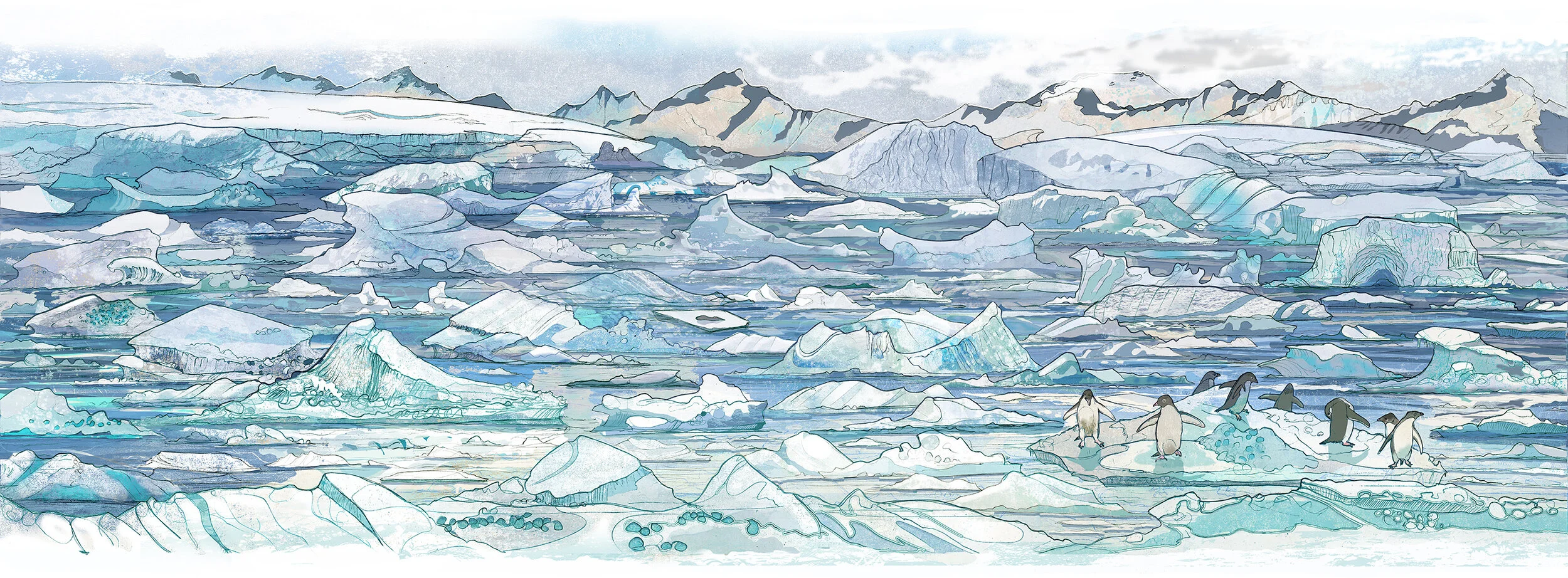
Antarctica Conservation
Presented by Artist, Shelly Perkins
“It is the task of all those who are privileged enough to visit Antarctica to champion its cause, by sharing with others the beauty and fragility of this remote part of our planet. It is my hope that my work will help to educate, delight and ignite a new generation of Antarctic protectors.”- Shelly Perkins (artist)
WHY IS ANTARCTICA IMPORTANT?
Just the name Antarctica sends a frisson of excitement down the spine of any would be adventurer. Pouring over maps of the continent names such as 'Paradise Harbour', 'Cape Disappointment', 'Crystal Sound' and 'Dismal Island' hint at the times of hardship, glory and elation experienced by early explorers 'on the ice'. Historically humans aimed to 'conquer' these forbidding lands, testing human endurance and enabling discovery and exploration in these wild places.
Today polar scientists explore the remote reaches of Antarctica to try and unlock information about climate change and to better understand particular facets of science such as glaciology to help us understand the impacts we humans are having on our planet.
The continent contains around 60% of the planet's freshwater, locked into its ice-sheet, as well as storing this water the bright white ice-sheet helps to reduce the earth's temperature by reflecting the sun's rays away from the surface of the Earth.
Antarctica also provides irreplaceable breeding and feeding grounds for a wide range of marine mammals and birds.
WHAT CHALLENGES IS ANTARCTICA FACING?
Our warming climate and oceans are already impacting the future for many animals who rely on this continent to live. Diminishing ice, reduced areas to rear young and a reduction in food sources are all effects of climate change and human impact on this region which are impacting this fragile ecosystem. Predictions show that a climate increase of just 1.3 degrees could wipe out 70% of the world's population of Adélie penguins. At the moment this humbling prediction is set to have taken its course before the end of the century.
When icebergs shear off glaciers it is often referred to as 'calving'. This very physical description implies new birth and in a way the creation of icebergs is almost like a sculptor chipping a crude lump of stone out of a block, ready to begin a masterwork. Over time the material will be honed into a thing of beauty, much like an iceberg. They ultimately become fine works of art, chipped and worn away by wind and water before melting into the blue. Their existence is transitory and increasingly too fleeting.Whilst the act of calving is a natural process, is it the speed at which this calving is taking place which is of grave concern. As our climate warms and Antarctic Glacial flow and calving increases so in turn do our sea levels.
WHAT CAN WE DO TO HELP?
Study Antarctica
Learn more about Antarctica by reading books, studying scientific papers and watching documentaries.
Read about Antarctica’s scientists findings and follow them on social media. Scientists are able to record the effects of global warming in a most tangible way in this part of our planet and the studies undertaken here are vital to informing us to what extent our planet is being damaged by human activity and global temperature increases.
Do some research on your national research body and the work they are doing in Antarctica. Many countries from around the world have a base on the continent, learning what they are studying and what their results are and looking for ways to help their funding would be a great start in helping to protect this region.
Celebrate Antarctica
Help younger generations to understand why Antarctica is such a vital habitat to protect. There are lots of great institutions and websites which can help you learn more about Antarctica. The Scott Polar Research institute has a fantastic museum in Cambridge, UK, with many online resources and information from their archives that are free to access. The museum currently has a range of online home-schooling challenges.
If you are fortunate enough to travel to this remote part of our planet share your experiences and inspire others to have empathy and a keenness to preserve and protect this region. Check up on the green credentials of your tour company provider. Discovering Antarctica has useful tips on choosing a good eco-tourism travel agent.
Create your own artworks about Antarctica and share them with the world. Use #CreatureConserve #AntarcticaArt hashtags when posting them online.
Protect Antarctica
Fundamentally our ultimate goal in keeping Antarctica the pristine and vital habitat that it is, is to stop climate change and minimise human impact on the environment.
Reduce litter and waste. Human impact from people directly visiting this continent is very well monitored and controlled, in my 6 weeks in Antarctica I didn't see any litter on land or in the ocean but it can and does occur. Chemicals being released into our seas and rubbish dumped thousands of miles away can still have an impact on this remote region as tidal currents globally are all connected. Reduce your impact on the oceans by reusing, recycling and requesting plastic free. Check that companies you are buying your products from have good 'green credentials': https://www.lessplastic.org.uk/9-ways-you-can-reduce-ocean-plastic/
Support science and responsible tourism. All tour operators within the Antarctic Treaty area are obligated by law to follow the guidelines set out by this international authority. Responsible and managed tourism can have a positive impact on wilderness areas as this often provides an income to help maintain and protect the most vulnerable parts of our planet. The International Association of Antarctica Tour Operators was founded to establish best practice for private-sector travel to Antarctica./



